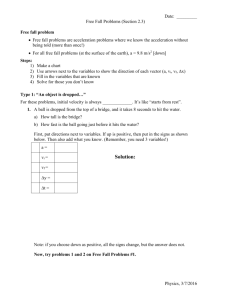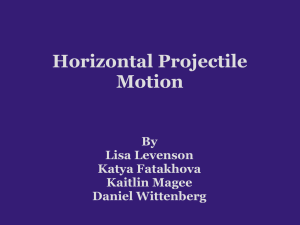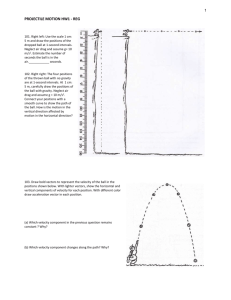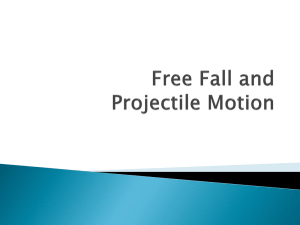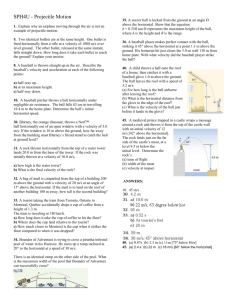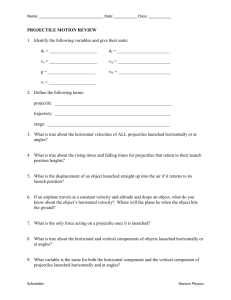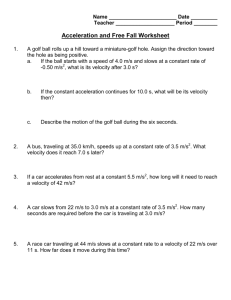Word
advertisement
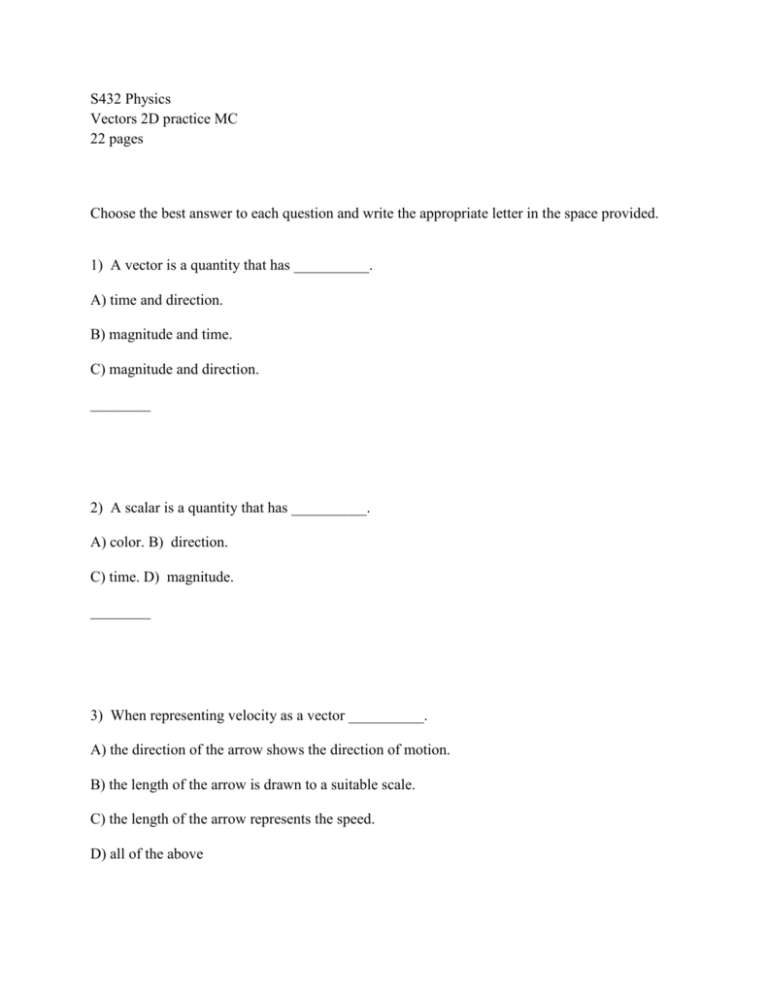
S432 Physics Vectors 2D practice MC 22 pages Choose the best answer to each question and write the appropriate letter in the space provided. 1) A vector is a quantity that has __________. A) time and direction. B) magnitude and time. C) magnitude and direction. ________ 2) A scalar is a quantity that has __________. A) color. B) direction. C) time. D) magnitude. ________ 3) When representing velocity as a vector __________. A) the direction of the arrow shows the direction of motion. B) the length of the arrow is drawn to a suitable scale. C) the length of the arrow represents the speed. D) all of the above E) none of the above ________ 4) Which of the following would NOT be considered a projectile? A) A cannonball rolling down a slope B) A cannonball thrown through the air C) A cannonball thrown straight up D) A cannonball rolling off the edge of a table E) All of the above are projectiles. ________ 5) The horizontal component of a projectile's velocity is independent of __________. A) the range of the projectile. B) the vertical component of its velocity. C) time. ________ 6) In the absence of air friction, the vertical component of a projectile's velocity doesn't change as the projectile moves. A) Always false B) Sometimes true C) Always true ________ 7) In the absence of air friction, the horizontal component of a projectile's velocity doesn't change as the projectile moves. A) Sometimes true B) Always false C) Always true ________ 8) At the instant a ball is thrown horizontally with a large force, an identical ball is dropped from the same height Which ball hits the ground first? A) Neither -- they both hit the ground at the same time. B) The dropped ball C) The horizontally thrown ball ________ 9) A ball is thrown into the air at some angle. At the very top of the ball's path, its velocity is __________. A) entirely vertical. B) entirely horizontal. C) There's not enough information given to determine. D) both vertical and horizontal. ________ 10) In the absence of air resistance, the angle at which a thrown ball will go the farthest is __________. A) 75 degrees. B) 15 degrees. C) 60 degrees. D) 30 degrees. E) 45 degrees. _______ 11) A ball thrown in the air will never go as far as physics ideally would predict because __________. A) air friction slows the ball. B) gravity is acting. C) one can never throw the ball fast enough. D) ideally the ball would never land. E) all of the above _______ 12) At what part of a path does a projectile have minimum speed? A) When it is thrown B) There's not enough information to say. C) When it returns to the ground D) Halfway to the top E) At the top of its path _______ 13) A cannonball is launched from the ground at an angle of 30 degrees above the horizontal and a speed of 20 m/s. Ideally (no air resistance) the ball will land on the ground with a speed of __________. A) 20 m/s. B) There is not enough information to say. C) 0 m/s. D) 10 m/s. E) 40 m/s. _______ 14) A projectile launched horizontally hits the ground in 0.5 seconds. If it had been launched with a much higher speed in the same direction, it would have hit the ground (neglecting the earth's curvature and air resistance) in __________. A) 0.5 s. B) less than 0.5 s. C) more than 0.5 s. _______ 15) An airplane flying into a head wind loses ground speed, and an airplane flying with the wind gains ground speed. If an airplane flies at right angles to the wind, then ground speed is __________. A) less. B) more. C) unchanged. _______ 16) Jose can jump vertically 1 meter from his skateboard when it is at rest. When the skateboard is moving horizontally, Jose can jump __________. A) no higher. B) higher. _______ 17) Which best approximates the resultant of a pair of 10-unit vectors at right angles to each other? A) 20 N. B) 10 N. C) 14 N. D) 0 N. _______ 18) What is the resultant of a 4-unit vector and 3-unit vector at right angles to each other? A) 5 units. B) 7 units. C) 1 unit. D) none of the above _______ 19) When in orbit, a satellite like the space shuttle is __________. A) free from earth's gravity. B) in non-accelerated motion. C) simply a projectile. _______ 20) "Hang time," is the time a jumper's feet are off the ground in a vertical jump. If the jumper runs horizontally and has the same vertical component of takeoff velocity, hang time will be __________. A) decreased. B) increased. C) no different. _______ 21) If you could throw a baseball horizontally at a speed of 8 km/s and if there were no air drag and nothing to stop it, __________. A) it would escape Earth. B) it would orbit Earth. C) after 90 minutes it would return to you. _______ 22) Suppose a small plane can fly at 200 km/h relative to the surrounding air. Suppose also that there is a 40-km/h tailwind. How fast does the plane's shadow move across the ground? A) 200 km/h B) 160 km/h C) 240 km/h D) 5 km/h E) 40 km/h _______ 23) At the instant a ball is thrown horizontally with a large force, an identical ball is dropped from the same height. Which ball hits the ground first? A) The dropped ball B) Neitherminusthey both hit the ground at the same time. C) The horizontally thrown ball _______ 24) A cannonball is fired at some angle into the air. In the first second it moves 10 meters horizontally. Assuming it doesn't hit the ground and air resistance is small, how far does it move horizontally in the next second? A) Less than 10 m B) There's not enough information to say. C) More than 10 m D) 10 m _______ 25) In the absence of air resistance, the angle at which a thrown ball will go the farthest is __________. A) 45 degrees. B) 60 degrees. C) 30 degrees. D) 15 degrees. E) 75 degrees. _______ 26) A ball is thrown straight upward at 20 m/s. Ideally (no air resistance), the ball will return to the thrower's hand with a speed of __________. A) 40 m/s. B) There is not enough information to say. C) 0 m/s. D) 20 m/s. E) 10 m/s. _______ 27) A cannon with a barrel velocity of 100 m/s launches a cannonball horizontally from a tower. Neglecting air resistance, where will the cannonball be 1 second later? A) 50 m downrange B) 98 m downrange C) 490 m downrange D) 100 m downrange E) none of the above _______ On a separate sheet of paper, answer the following questions. 28) A plane flies north at 200 km/h. At the same time, there is wind of 50 km/h from the west. Use both the graphical method and the Pythagorean Theorem to find the resultant velocity of the plane. How closely do your answers agree? Answer the following questions in the space provided. Show all work. 29) A boat is rowed at 4.0 km/h directly across a river in water that is flowing at right angles at 8.0 km/h. What is the resulting speed of the boat? _____________ 30) Harry accidentally falls out of a helicopter that is traveling horizontally at 60 m/s. He plunges into the water below 3.00 seconds later. Assuming no air resistance, what is the horizontal distance he travels while falling? _____________ 31) Harry jumps horizontally from the top of a building that is 20.0 m high. He hopes to reach a swimming pool that is at the bottom of the building, 14 m horizontally from the edge the building. If he is to reach the pool, what must his jumping speed be? _____________ 32) An airplane whose airspeed is 200 km/h flies parallel to the direction of a wind with a speed of 90.0 km/h. What are the two possible speeds of the plane relative to the ground? _____________ 33) Consider an escalator at an angle of 45degree above the horizontal that moves with a velocity of 3.0 m/s. What is the vertical component of the escalator's velocity? _____________ 34) A ball is thrown horizontally from the top of a tall cliff. Neglecting air drag, what vertical distance has the ball fallen 3.0 seconds later? _____________ 35) A ball rolls off the edge of a horizontal roof at a velocity of 10 m/s. What is the speed of the ball one second later? _____________ 36) A projectile shot with an initial velocity of 101 m/s at an angle of 45degree follows a parabolic path and hits a stationary balloon at the top of its trajectory. With what speed does the projectile hit the balloon? _____________ 37) A ball is thrown upward. Its initial vertical component of velocity is 41 m/s, and its initial horizontal component of velocity is 10 m/s. What is the ball's speed one second later? _____________ 38) A ball is thrown upward. Its initial vertical component of velocity is 61 m/s, and its initial horizontal component of velocity is 10 m/s. What is the ball's speed two seconds later? _____________ 39) A ball is thrown upward. Its initial vertical component of velocity is 73 m/s, and its initial horizontal component of velocity is 10 m/s. What is the ball's speed three seconds later? _____________ 40) In a standing jump, the hang time of a certain athlete is 0.6 second. What is her hang time when she jumps the same height while moving horizontally? _____________ 1) Answer: C 2) Answer: D 3) Answer: D 4) Answer: A 5) Answer: B 6) Answer: A 7) Answer: C 8) Answer: A 9) Answer: B 10) Answer: E 11) Answer: A 12) Answer: E 13) Answer: A 14) Answer: A 15) Answer: B 16) Answer: A 17) Answer: C 18) Answer: A 19) Answer: C 20) Answer: C 21) Answer: B 22) Answer: C 23) Answer: B 24) Answer: D 25) Answer: A 26) Answer: D 27) Answer: D 28) Answer: Resultant velocity of the plane = sqrt(200 to power of (2)plus50 to power of (2)) km/h = 206 km/h. In general, the graphical method will not be as precise as the analytical method. However, the answers should be within a few percent of each other. 29) Answer: 8.9 km/h 30) Answer: 180 m 31) Answer: 7.0 m/s 32) Answer: 110 and 290 km/h 33) Answer: 2.1 m/s 34) Answer: 45 m 35) Answer: 14 m/s 36) Answer: 71.4 m/s 37) Answer: 33 m/s 38) Answer: 42 m/s 39) Answer: 44 m/s 40) Answer: 0.6 s

